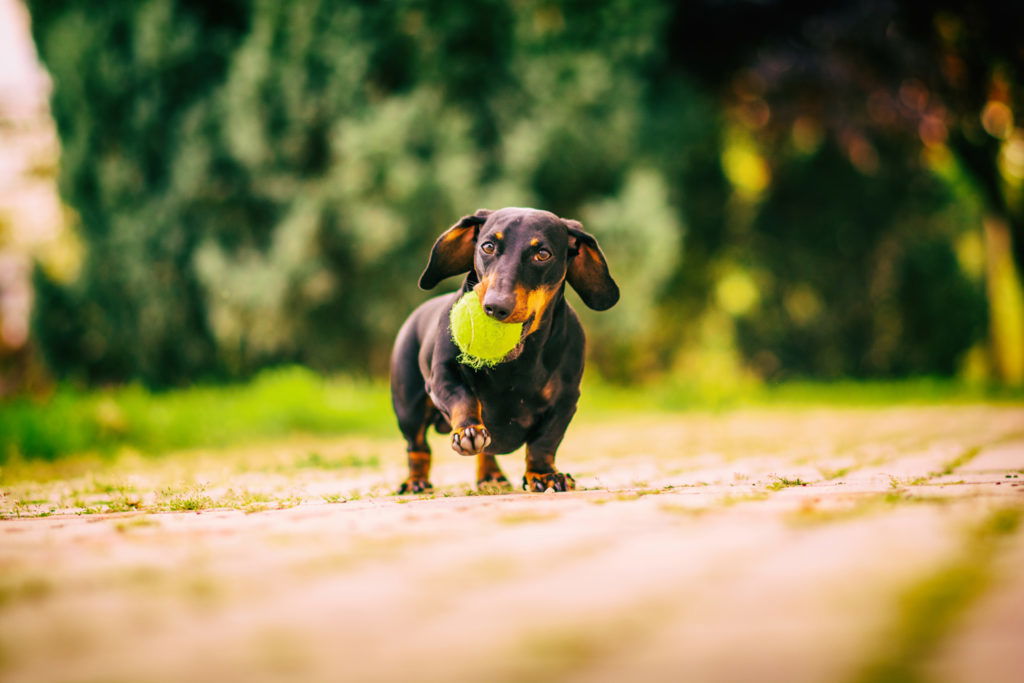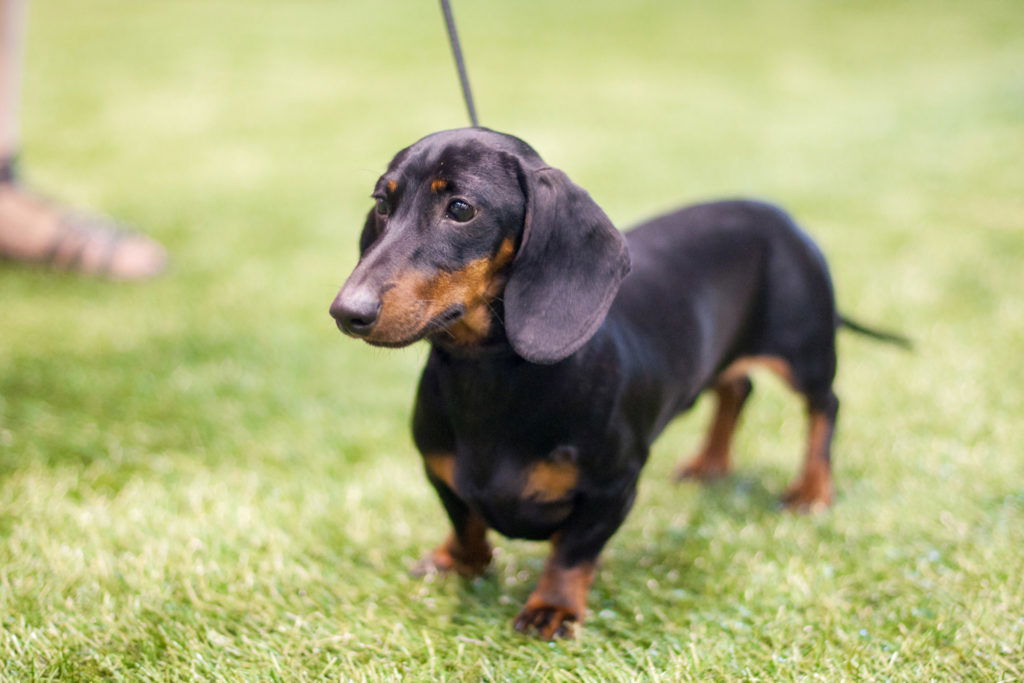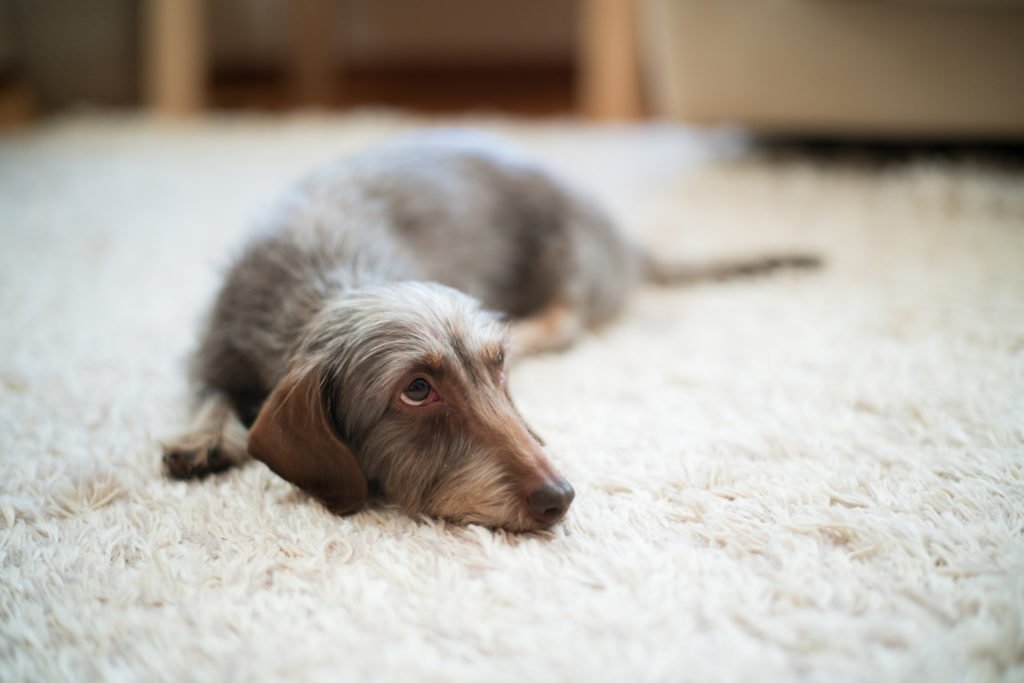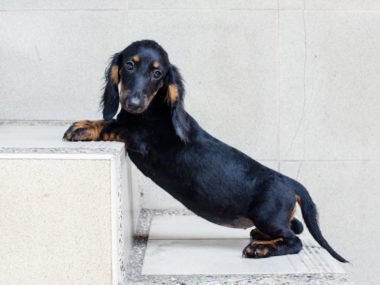Does your dachshund mind being alone when you’re out? Does he get stressed? How can you stop him feeling scared on his own? We’re here to answer your questions about dachshunds and separation anxiety.
Do dachshunds get separation anxiety? Yes, dachshunds can get separation anxiety. They’re pack dogs and don’t like being alone for too long. If you need to leave your dachshund on his own, you’ll have to train him to feel comfortable when alone. Don’t leave a dachshund for more than 4 hours at a time.
If you think your dachshund has separation anxiety, or you want to know how to stop your new sausage from getting it, read on to find out what causes separation anxiety, how to spot the signs and what you can do about it.
Table of Contents
- Are dachshunds prone to separation anxiety?
- Does my dachshund have separation anxiety?
- Should I video my dachshund when I’m not home?
- What do I do if my dachshund has separation anxiety?
- How do you treat severe separation anxiety in dachshunds?
- How do you discipline a dachshund?
- Can dachshunds handle change?
- Will getting another dog help my dachshund’s separation anxiety?
Are dachshunds prone to separation anxiety?
Yes, dachshunds are prone to separation anxiety. They’re pack animals and love being around people or other dogs. And they’re used to doing everything as a team. If they haven’t been trained to stay at home alone, they can develop mild to severe anxiety.

In the home, your family is your dachshund’s pack, so he can get scared when he’s suddenly left alone to fend for himself. Mild symptoms can be helped with clever distraction and proper preparation before you go out. Severe anxiety needs patient training to help him overcome his fear and cope with being alone.
If you’ve had your dachshund since a puppy, maybe you haven’t left him alone enough and he’s become too clingy and dependant on you and this has led to separation anxiety.
Or, if your dachshund is a rescue, he might already have issues with separation, or may have been treated badly in his old home and has clung to you because you rescued him (which basically means he freaks out when you’re not there).
Does my dachshund have separation anxiety?
These are the signs of separation anxiety in dachshunds:
- Barking and howling
- Pacing around the house
- Chewing things or ripping them up
- Scratching at doors and trying to escape
- Pooing and eating it

If your dachshund is only ever destructive or disruptive while you’re out, he may have separation anxiety. But if he’s always chewing things or barking loudly, even when you’re around, it might just be boredom, attention-seeking or another kind of behavioural issue.
It’s not always easy to tell if your dachshund has separation anxiety – especially if he only plays up while you’re out. But if you want to know how he’s getting on at home, just set up a camera so you can see how he reacts when you’re out. And make sure it has sound to catch any barking.
Signs to watch for before you leave
- Drooling
- Whining
- Increased excitement
- Trying to stop you leaving
- Getting worked up before you leave
- Attention-seeking
Signs to watch for while you’re gone
- Barking and howling
- Pacing around
- Chewing things or ripping them up
- Scratching at doors and trying to escape
- Pooing and eating it
Signs to watch for when you get home
- Excessive tail wagging, jumping up and over-excitement
- Wee or poo on the floor
- Chew marks on door frames, skirting boards, cupboards or corners of walls
- Chewed shoes or ripped up sofa cushions
- Dig or scratch marks around the door
- Injuries on his teeth, nose or paws
- Your neighbour may tell you he’s barking or crying
- Someone may complain about the noise
Should I video my dachshund when I’m not home?
Yes, setting up a camera to video your dachshund while you’re not there is a great idea. You’ll be able to see what he does and how anxious he is. If you’ve left him food to eat or a treat like a stuffed Kong and he doesn’t touch it, you’ll know he’s stressed.

Even if you don’t have video or a live feed, look for the signs and you should be able to see the evidence of whether your dachshund was destructive or disruptive while you were out.
What do I do if my dachshund has separation anxiety?
If your dachshund has separation anxiety:
- Keep to a schedule
- Don’t make a big deal of leaving and coming home
- Tire him out before you leave
- Make sure his bed is nice and cosy
- Distract him with a stuffed Kong toy
- Get a Furbo camera
- Make sure he gets regular breaks
- Teach him to be more independent
If your dachshund has mild or severe separation anxiety, you need to help him feel more comfortable when he’s home alone. This can take a lot of time, so be patient and never punish or shout at your dachshund for getting it wrong. This is what you need to do:
Keep to a schedule
Stick to the same times for feeding and exercising your dachshund, and leaving the house and coming home. If you work during the day, have set times where someone else comes in to take him out for a wee. Having a routine should make him feel less anxious as he’ll know what’s happening and when.

Don’t make a big deal of leaving and coming home
A good rule is to ignore your dachshund 10 minutes either side of leaving and coming home. Just do exactly what you’d do if your dachshund wasn’t there. If he comes to you for attention when you walk through the door, just ignore him. This can be one of the hardest things to do, but it’s in his best interests as it stops it turning into a big event.
Tire your dachshund out before you leave
Your dachshund will relax more easily if he’s tired and doesn’t have pent-up energy. Take him for a long walk before you go to work or play with him to tire him out. This should help him sleep for a few hours when you’re not there. If he’s still a pup, stick to the ‘5 minutes per month of age rule’ for exercise up until he’s 12 months old.

Make sure his bed is nice and cosy
Dachshunds are burrowers and like a cosy space they can curl up and sleep in. They like snuggly blankets and lots of comfort. It can be a good idea to leave something that smells of you in his bed to keep him calm when you’re out. If you’re crate training, make sure he has all he needs in there. Cover the top of the crate with a blanket to create a den (leaving the front uncovered so he can see out) and leave the radio on low to keep him company. You basically want to create a space and environment he’s happy and comfortable in.
Distract your dachshund with a stuffed Kong toy
Giving your dachshund any type of food reward is great because he’ll learn to associate being alone with tasty treats. Kongs are especially good because they’ll give him mental stimulation, and should keep him distracted for hours. Don’t leave food out in a bowl as it won’t last 5 minutes and he’ll need to poop afterwards. If your dachshund needs feeding while you’re at work, it’s better to get some to pop in and do that for you.
Get a Furbo camera to watch your dachshund
A Furbo is an interactive pet camera that allows you to remotely check in your dachshund when you’re not there. So if your dachshund is anxious or stressed you can calm him down by talking to him. You can give him the comfort and reassurance he needs and even dispense a treat! Having that contact with each other and being able to watch a live feed, will definitely put your mind at ease! If he doesn’t settle and needs more help, you’ll know about it, and can then arrange for someone to call in during the day.
Make sure your dachshund gets regular breaks
If you have to leave your dachshund for more than 4 hours, arrange for someone to come over to take him out for the toilet and give him some attention or a walk. Ask a friend or relative, or hire a dog-walker or sitter to look after him for a few hours during the day. This is also a great option if you work irregular hours, as it gives your dachshund structure to his day.

Teach your dachshund to be more independent
Cuddling your dachshund and spending every waking moment glued to him can be a lovely thing. But it can also go too far, especially when he’s young and you’re training him. Dachshunds need to learn to be independent as it helps them when you leave the house.
The best way to start is to teach him his place in the pack. Do this by spending time apart from him, not letting him on sofa or beds and, even though it’s hard, not always giving in to his demands. Just put his bed on the floor by your feet so he learns his place. When he’s older and trained you can give him much more freedom and allow him wherever you want.

Constantly picking him up, having him on your lap and mollycoddling him will make him feel like he has something to worry about when you do go out. It may be nice for you to have a furry companion keeping your lap warm, but you have to think what’s in his best interests too.
How do you treat severe separation anxiety in dachshunds?
If your dachshund has severe separation anxiety, you’ll need to be patient and train him to be left on his own. Help him relax as you prepare to leave and only leave him for short periods and build up. If his anxiety continues, work with a dog behaviourist.

This is what you need to do:
Help your dachshund relax as you prepare to leave
Dachshunds can get really worked up when they sense you’re about to go out. The first step in your dachshund’s training is to reduce his stress at this stage. He needs to learn nothing bad is going to happen when you put on your coat and shoes and pick up your keys.
So, what you need to do is get ready to go out – put your shoes and coat on and everything – and then go and do something else in the home. Sit down and read a book or have a cup of coffee. Don’t interact with your dachshund as you do this – act like it’s totally normal and no big deal. Do this every day, at least 3 times a day, until he’s totally relaxed and doesn’t pay attention to you getting ready to leave. It might take a while.
Leave your dachshund for short periods and build up
The next step is to start leaving your dachshund alone in the house for very short periods. Get your coat and shoes on, pick up your keys, and step outside the house. Start with just 30 seconds. When you come back in, ignore your dachshund and carry on as usual. If he’s calm, you can increase the length of the separation next time you do it.
You probably only want to do this 3 or 4 times a day so he doesn’t get stressed or anxious. Over the following weeks, build up the length of time you leave him alone. This may take a while at first but, as he gets more confident, you’ll be able to increase the time by quite a bit.

If your dachshund has really bad separation anxiety, you might want to start with just leaving him alone in a room, rather than leaving the house. Don’t ever shut him in a room on his own – go into another room and shut the door so you’re the one who’s closed in. When you think he’s ready, you can start leaving him in the house on his own for short periods of time. If your dachshund gets stressed at any point, go back a few steps until he’s calm and go a bit slower.
Work with a behaviourist
Sometimes, for really bad cases, you may need the help of a dog behaviourist to deal with ingrained issues and anxiety problems. This is a really good idea because you want to stop the issue before it gets out of hand and do everything you can to keep your dachshund from getting stressed. Just speak to your local vet and they’ll organise the appointment or point you in the right direction.
How do you discipline a dachshund?
Never physically discipline or shout at your dachshund. The best way is to ignore bad behaviour and move his attention elsewhere and reward good behaviour by giving lots of fuss, praise and treats when he does the right thing.
Can dachshunds handle change?
Dachshunds are sensitive to any life change and can find it stressful. If you get a new job and his routine changes, if you move home or someone moves in or out of your house, it can make dachshunds feel extra anxious and they can develop symptoms of separation anxiety.
Will getting another dog help my dachshund’s separation anxiety?
No. Dachshunds are pack animals that want to live as part of a pack, regardless of whether that’s with people or other dogs. But, you should never get another dachshund to treat the separation anxiety of the first. The two dogs may stress each other out and end up making the whole situation much worse.
You must deal with the behavioural issues in the first dachshund before bringing a second one into your home.
If your dachshund seems content on his own but might benefit from a pal to prevent any separation anxiety in the future, then getting another dachshund may be a good idea. In general, the dachshunds that cope best when left on their own either have people dropping in every 4 hours or so, or they have other dogs (or cats!) in the home that keep them company.
So there you have it, dachshunds are pack animals and love being with people, but they’re also prone to separation anxiety and can get stressed if left alone too long. No one wants a stressed dachshund, so just make sure you stick to the same daily schedule, don’t make a big deal of leaving the house or coming home, walk him daily to tire him out, leave toys and stuffed Kongs when you go out, and make sure he gets out during the day and isn’t left alone for more than 4 hours at a time. Doing all of these things and getting into a routine should make your sausage feel so much happier when he’s home alone.







